sensor Abarth 124 Spider 2021 Owner handbook (in English)
[x] Cancel search | Manufacturer: ABARTH, Model Year: 2021, Model line: 124 Spider, Model: Abarth 124 Spider 2021Pages: 224, PDF Size: 3.9 MB
Page 81 of 224

When changing tires yourself:ifyou
or someone else changes tires, you or
someone else can also undertake the
steps for the TPMS to complete the ID
signal code registration:
after tires have been changed, switch
the ignition ON, then back to ACC or
OFF;
wait for about 15 minutes;
after about 15 minutes, drive the
vehicle at a speed of at least 25 km/h
for 10 minutes and the tire pressure
sensor ID signal code will be registered
automatically.
IMPORTANT If the vehicle is driven
within about 15 minutes of changing
tires, the
warning light will flash
because the sensor ID signal code
would not have been registered. If this
happens, park the vehicle for about
15 minutes, after which the sensor ID
signal code will register upon driving the
vehicle for 10 minutes.
Replacing tires and wheels
IMPORTANT When replacing/repairing
the tires or wheels or both, have the
work done by an Abarth Dealership, or
the tire pressure sensors may be
damaged.
IMPORTANT The wheels equipped on
your vehicle are specially designed for
installation of the tire pressure sensors.Do not use non-genuine wheels,
otherwise it may not be possible to
install the tire pressure sensors.
Be sure to have the tire pressure
sensors installed whenever tires or
wheels are replaced.
When having a tire or wheel or both
replaced, the following types of tire
pressure sensor installations are
possible:
the tire pressure sensor is removed
from the old wheel and installed to the
new one;
the same tire pressure sensor is used
with the same wheel. Only the tire is
replaced;
a new tire pressure sensor is installed
to a new wheel.
IMPORTANT The tire pressure sensor
ID signal code must be registered when
a new tire pressure sensor is
purchased. For purchase of a tire
pressure sensor and registration of the
tire pressure sensor ID signal code,
consult an Abarth Dealership.
IMPORTANT When reinstalling a
previously removed tire pressure sensor
to a wheel, replace the grommet (seal
between valve body/sensor and wheel)
for the tire pressure sensor.
MECHANICAL LIMITED
SLIP DIFFERENTIAL
Your vehicle is equipped with a
mechanical limited slip differential. In
particular this vehicle adopts a
super-LSD which guarantees improved
vehicle traction and handling.
A super-LSD with a low torque bias
ratio (*) has been adopted to improve
performance when starting from a
standstill, driving straight-ahead and
response.
(*)Torque bias ratio: when a wheel
slips due to a low-traction surface, the
LSD provides proportionally more
torque to the opposite wheel. The
torque bias ratio is the ratio of torque
supplied to the right and left wheels in
such cases, and represents the
performance capability of the LSD.
The super-LSD is a torque-sensing type
that provides improved driving stability
due to the following characteristics:
low torque bias ratio provides
improved controllability (torque bias
ratio: 2.0);
creation of initial torque provides
improved starting from a standstill and
acceleration/deceleration response, and
driving straight-ahead (initial torque:
49 Nm);
simplified construction provides
weight reduction.
79
Page 87 of 224
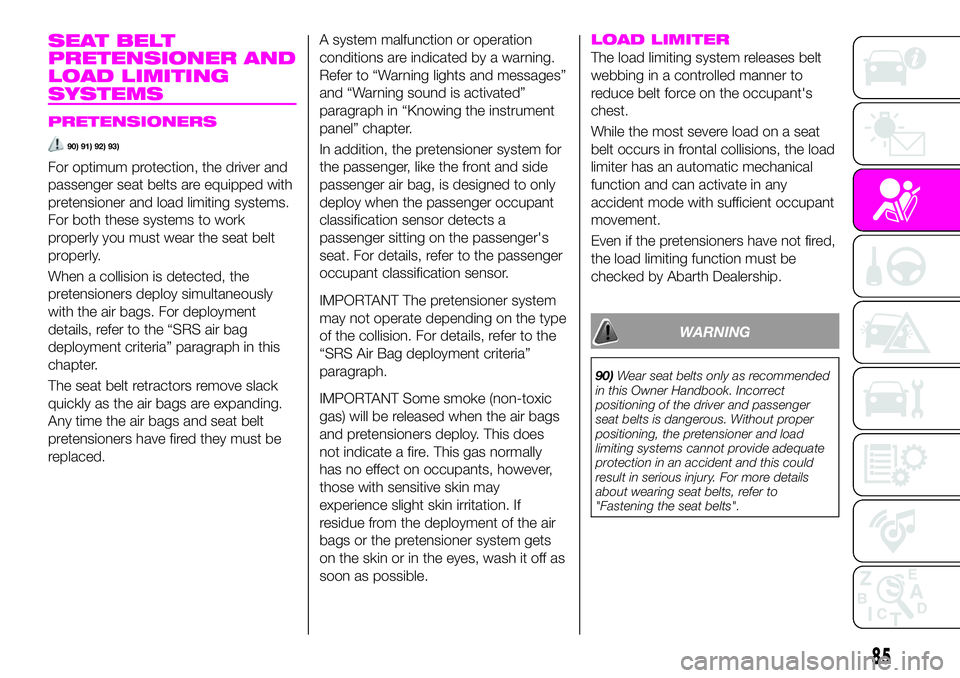
SEAT BELT
PRETENSIONER AND
LOAD LIMITING
SYSTEMS
PRETENSIONERS
90) 91) 92) 93)
For optimum protection, the driver and
passenger seat belts are equipped with
pretensioner and load limiting systems.
For both these systems to work
properly you must wear the seat belt
properly.
When a collision is detected, the
pretensioners deploy simultaneously
with the air bags. For deployment
details, refer to the “SRS air bag
deployment criteria” paragraph in this
chapter.
The seat belt retractors remove slack
quickly as the air bags are expanding.
Any time the air bags and seat belt
pretensioners have fired they must be
replaced.A system malfunction or operation
conditions are indicated by a warning.
Refer to “Warning lights and messages”
and “Warning sound is activated”
paragraph in “Knowing the instrument
panel” chapter.
In addition, the pretensioner system for
the passenger, like the front and side
passenger air bag, is designed to only
deploy when the passenger occupant
classification sensor detects a
passenger sitting on the passenger's
seat. For details, refer to the passenger
occupant classification sensor.
IMPORTANT The pretensioner system
may not operate depending on the type
of the collision. For details, refer to the
“SRS Air Bag deployment criteria”
paragraph.
IMPORTANT Some smoke (non-toxic
gas) will be released when the air bags
and pretensioners deploy. This does
not indicate a fire. This gas normally
has no effect on occupants, however,
those with sensitive skin may
experience slight skin irritation. If
residue from the deployment of the air
bags or the pretensioner system gets
on the skin or in the eyes, wash it off as
soon as possible.
LOAD LIMITER
The load limiting system releases belt
webbing in a controlled manner to
reduce belt force on the occupant's
chest.
While the most severe load on a seat
belt occurs in frontal collisions, the load
limiter has an automatic mechanical
function and can activate in any
accident mode with sufficient occupant
movement.
Even if the pretensioners have not fired,
the load limiting function must be
checked by Abarth Dealership.
WARNING
90)Wear seat belts only as recommended
in this Owner Handbook. Incorrect
positioning of the driver and passenger
seat belts is dangerous. Without proper
positioning, the pretensioner and load
limiting systems cannot provide adequate
protection in an accident and this could
result in serious injury. For more details
about wearing seat belts, refer to
"Fastening the seat belts".
85
Page 88 of 224
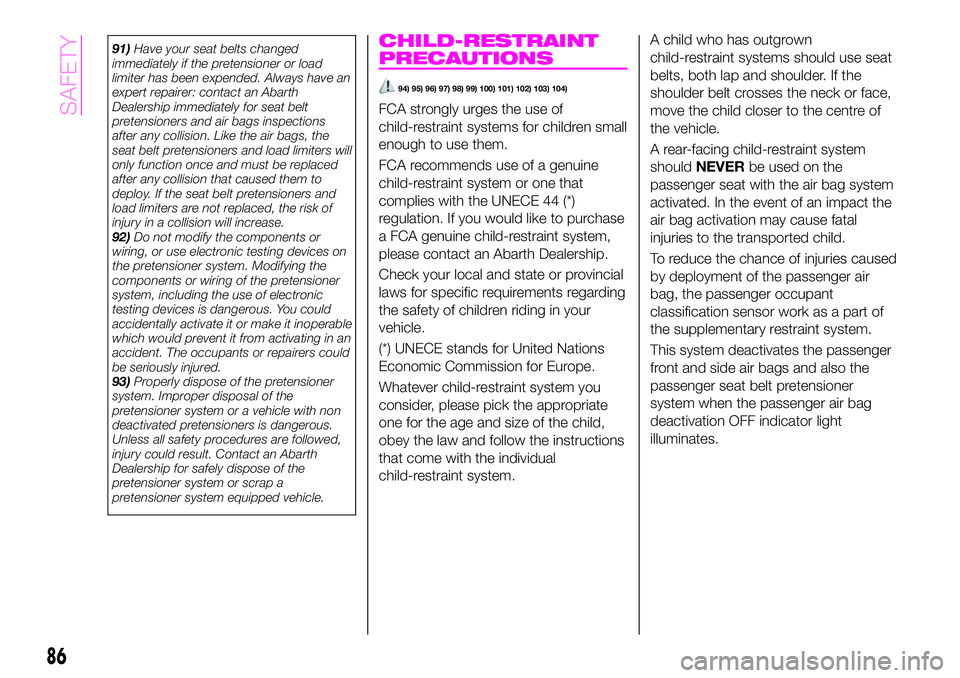
91)Have your seat belts changed
immediately if the pretensioner or load
limiter has been expended. Always have an
expert repairer: contact an Abarth
Dealership immediately for seat belt
pretensioners and air bags inspections
after any collision. Like the air bags, the
seat belt pretensioners and load limiters will
only function once and must be replaced
after any collision that caused them to
deploy. If the seat belt pretensioners and
load limiters are not replaced, the risk of
injury in a collision will increase.
92)Do not modify the components or
wiring, or use electronic testing devices on
the pretensioner system. Modifying the
components or wiring of the pretensioner
system, including the use of electronic
testing devices is dangerous. You could
accidentally activate it or make it inoperable
which would prevent it from activating in an
accident. The occupants or repairers could
be seriously injured.
93)Properly dispose of the pretensioner
system. Improper disposal of the
pretensioner system or a vehicle with non
deactivated pretensioners is dangerous.
Unless all safety procedures are followed,
injury could result. Contact an Abarth
Dealership for safely dispose of the
pretensioner system or scrap a
pretensioner system equipped vehicle.CHILD-RESTRAINT
PRECAUTIONS
94) 95) 96) 97) 98) 99) 100) 101) 102) 103) 104)
FCA strongly urges the use of
child-restraint systems for children small
enough to use them.
FCA recommends use of a genuine
child-restraint system or one that
complies with the UNECE 44 (*)
regulation. If you would like to purchase
a FCA genuine child-restraint system,
please contact an Abarth Dealership.
Check your local and state or provincial
laws for specific requirements regarding
the safety of children riding in your
vehicle.
(*) UNECE stands for United Nations
Economic Commission for Europe.
Whatever child-restraint system you
consider, please pick the appropriate
one for the age and size of the child,
obey the law and follow the instructions
that come with the individual
child-restraint system.A child who has outgrown
child-restraint systems should use seat
belts, both lap and shoulder. If the
shoulder belt crosses the neck or face,
move the child closer to the centre of
the vehicle.
A rear-facing child-restraint system
shouldNEVERbe used on the
passenger seat with the air bag system
activated. In the event of an impact the
air bag activation may cause fatal
injuries to the transported child.
To reduce the chance of injuries caused
by deployment of the passenger air
bag, the passenger occupant
classification sensor work as a part of
the supplementary restraint system.
This system deactivates the passenger
front and side air bags and also the
passenger seat belt pretensioner
system when the passenger air bag
deactivation OFF indicator light
illuminates.
86
SAFETY
Page 89 of 224
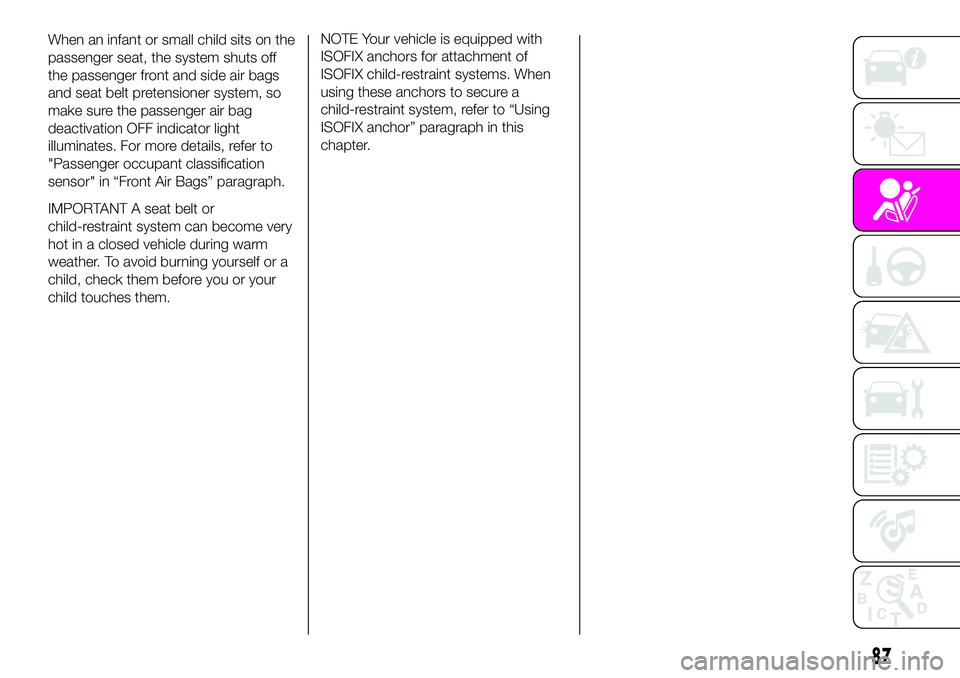
When an infant or small child sits on the
passenger seat, the system shuts off
the passenger front and side air bags
and seat belt pretensioner system, so
make sure the passenger air bag
deactivation OFF indicator light
illuminates. For more details, refer to
"Passenger occupant classification
sensor" in “Front Air Bags” paragraph.
IMPORTANT A seat belt or
child-restraint system can become very
hot in a closed vehicle during warm
weather. To avoid burning yourself or a
child, check them before you or your
child touches them.
NOTE Your vehicle is equipped with
ISOFIX anchors for attachment of
ISOFIX child-restraint systems. When
using these anchors to secure a
child-restraint system, refer to “Using
ISOFIX anchor” paragraph in this
chapter.
87
Page 99 of 224
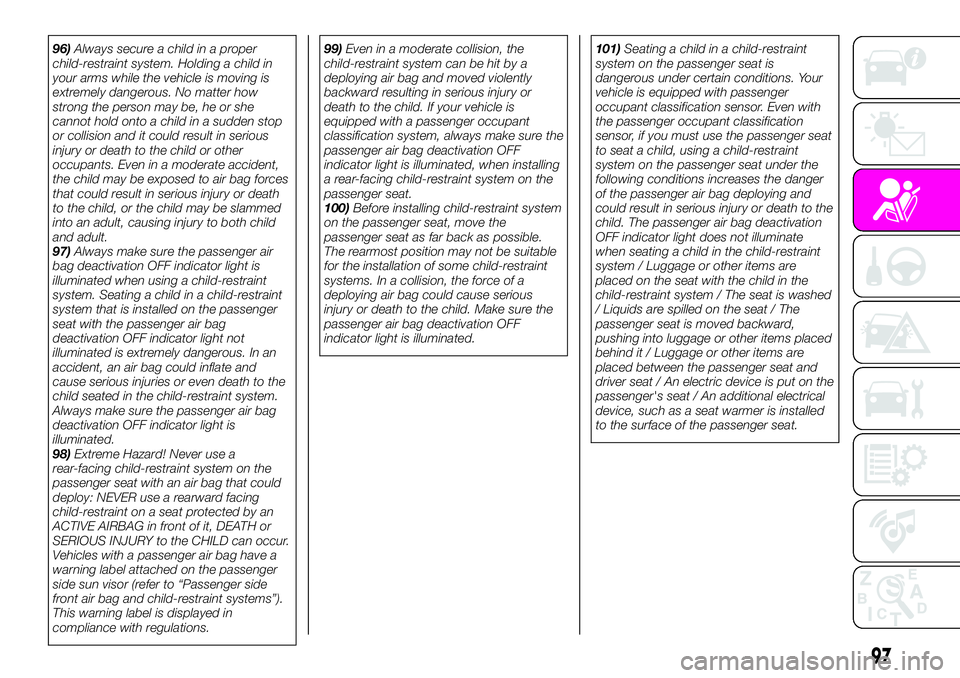
96)Always secure a child in a proper
child-restraint system. Holding a child in
your arms while the vehicle is moving is
extremely dangerous. No matter how
strong the person may be, he or she
cannot hold onto a child in a sudden stop
or collision and it could result in serious
injury or death to the child or other
occupants. Even in a moderate accident,
the child may be exposed to air bag forces
that could result in serious injury or death
to the child, or the child may be slammed
into an adult, causing injury to both child
and adult.
97)Always make sure the passenger air
bag deactivation OFF indicator light is
illuminated when using a child-restraint
system. Seating a child in a child-restraint
system that is installed on the passenger
seat with the passenger air bag
deactivation OFF indicator light not
illuminated is extremely dangerous. In an
accident, an air bag could inflate and
cause serious injuries or even death to the
child seated in the child-restraint system.
Always make sure the passenger air bag
deactivation OFF indicator light is
illuminated.
98)Extreme Hazard! Never use a
rear-facing child-restraint system on the
passenger seat with an air bag that could
deploy: NEVER use a rearward facing
child-restraint on a seat protected by an
ACTIVE AIRBAG in front of it, DEATH or
SERIOUS INJURY to the CHILD can occur.
Vehicles with a passenger air bag have a
warning label attached on the passenger
side sun visor (refer to “Passenger side
front air bag and child-restraint systems”).
This warning label is displayed in
compliance with regulations.99)Even in a moderate collision, the
child-restraint system can be hit by a
deploying air bag and moved violently
backward resulting in serious injury or
death to the child. If your vehicle is
equipped with a passenger occupant
classification system, always make sure the
passenger air bag deactivation OFF
indicator light is illuminated, when installing
a rear-facing child-restraint system on the
passenger seat.
100)Before installing child-restraint system
on the passenger seat, move the
passenger seat as far back as possible.
The rearmost position may not be suitable
for the installation of some child-restraint
systems. In a collision, the force of a
deploying air bag could cause serious
injury or death to the child. Make sure the
passenger air bag deactivation OFF
indicator light is illuminated.101)Seating a child in a child-restraint
system on the passenger seat is
dangerous under certain conditions. Your
vehicle is equipped with passenger
occupant classification sensor. Even with
the passenger occupant classification
sensor, if you must use the passenger seat
to seat a child, using a child-restraint
system on the passenger seat under the
following conditions increases the danger
of the passenger air bag deploying and
could result in serious injury or death to the
child. The passenger air bag deactivation
OFF indicator light does not illuminate
when seating a child in the child-restraint
system / Luggage or other items are
placed on the seat with the child in the
child-restraint system / The seat is washed
/ Liquids are spilled on the seat / The
passenger seat is moved backward,
pushing into luggage or other items placed
behind it / Luggage or other items are
placed between the passenger seat and
driver seat / An electric device is put on the
passenger's seat / An additional electrical
device, such as a seat warmer is installed
to the surface of the passenger seat.
97
Page 103 of 224

SUPPLEMENTARY RESTRAINT SYSTEM COMPONENTS
1Driver/Passenger inflators and air bags
2Crash sensors and diagnostic module (SAS unit)
3Seat belt pretensioners
4Front air bag sensors
5Side crash sensors
6Air bag/seat belt pretensioner system warning light
7Side inflators and air bags
8Passenger air bag deactivation indicator light
9Passenger occupant classification sensor
10Passenger occupant classification module
7503040300-121-002AB
101
Page 104 of 224

HOW THE SRS AIR BAGS
WORK
119) 120) 121) 122) 123) 124) 125) 126) 127) 128) 129) 130)
131)
Your vehicle is equipped with the
following types of SRS air bags. SRS air
bags are designed to work together
with the seat belts to help to reduce
injuries during an accident. The SRS air
bags are designed to provide further
protection for passengers in addition to
the seat belt functions. Be sure to wear
seat belts properly.
Seat Belt Pretensioners
The seat belt pretensioners are
designed to deploy in moderate or
severe frontal, near frontal collisions. In
addition, during a side collision, the
pretensioner operates on the side in
which the collision occurs. The
pretensioners operate differently
depending on what types of air bags
are equipped. For more details on the
seat belt pretensioner operation, refer
to the “SRS Air Bag deployment
criteria” paragraph.
Driver Air Bag
The driver's air bag is mounted in the
steering wheel fig. 76.
When air bag crash sensors detect a
frontal impact of greater than moderate
force, the driver's air bag inflates quickly
helping to reduce injury mainly to the
driver's head or chest caused by
directly hitting the steering wheel. For
more details about air bag deployment,
refer to "SRS Air Bag deployment
criteria" in this chapter.
Passenger Air Bag(Single stage)
The passenger air bag is mounted in
the passenger dashboard fig. 77.
The inflation mechanism for the
passenger air bag is the same as the
driver's air bag. For more details about
air bag deployment, refer to "SRS Air
Bag deployment criteria" in this chapter.
In addition, the passenger air bag is
designed to only deploy when the
passenger occupant classification
sensor detects a passenger sitting on
the passenger's seat. For more details
about air bag deployment, refer to
"SRS Air Bag deployment criteria" in
this chapter.
7606010203-126-123AB
7706010204-126-123AB
102
SAFETY
Page 105 of 224
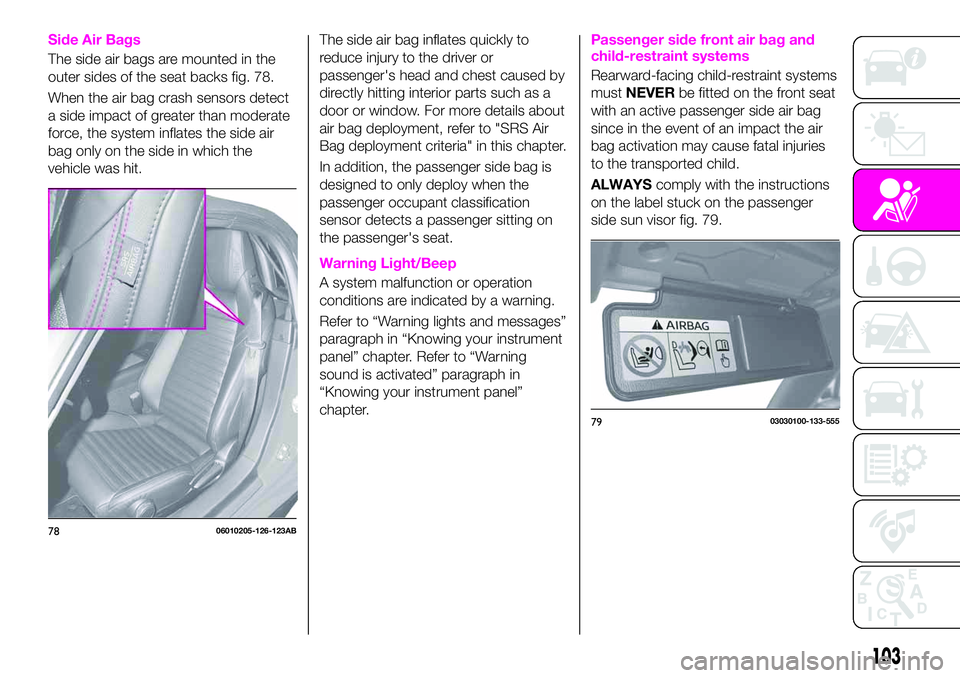
Side Air Bags
The side air bags are mounted in the
outer sides of the seat backs fig. 78.
When the air bag crash sensors detect
a side impact of greater than moderate
force, the system inflates the side air
bag only on the side in which the
vehicle was hit.The side air bag inflates quickly to
reduce injury to the driver or
passenger's head and chest caused by
directly hitting interior parts such as a
door or window. For more details about
air bag deployment, refer to "SRS Air
Bag deployment criteria" in this chapter.
In addition, the passenger side bag is
designed to only deploy when the
passenger occupant classification
sensor detects a passenger sitting on
the passenger's seat.
Warning Light/Beep
A system malfunction or operation
conditions are indicated by a warning.
Refer to “Warning lights and messages”
paragraph in “Knowing your instrument
panel” chapter. Refer to “Warning
sound is activated” paragraph in
“Knowing your instrument panel”
chapter.
Passenger side front air bag and
child-restraint systems
Rearward-facing child-restraint systems
mustNEVERbe fitted on the front seat
with an active passenger side air bag
since in the event of an impact the air
bag activation may cause fatal injuries
to the transported child.
ALWAYScomply with the instructions
on the label stuck on the passenger
side sun visor fig. 79.
7806010205-126-123AB
7903030100-133-555
103
Page 107 of 224

X: the SRS air bag equipment is designed to deploy in a collision.
(*) In a side collision, the seat belt pretensioners and the side air bags deploy (only on the side in which the collision occurs).
(**) The passenger front and side air bags and the seat belt pretensioner are designed to deploy when the passenger occupant
classification sensor detects a passenger sitting on the passenger's seat.
IMPORTANT In a frontal offset collision, the equipped air bags and pretensioners may all deploy depending on the direction,
angle, and rate of impact.
105
Page 109 of 224
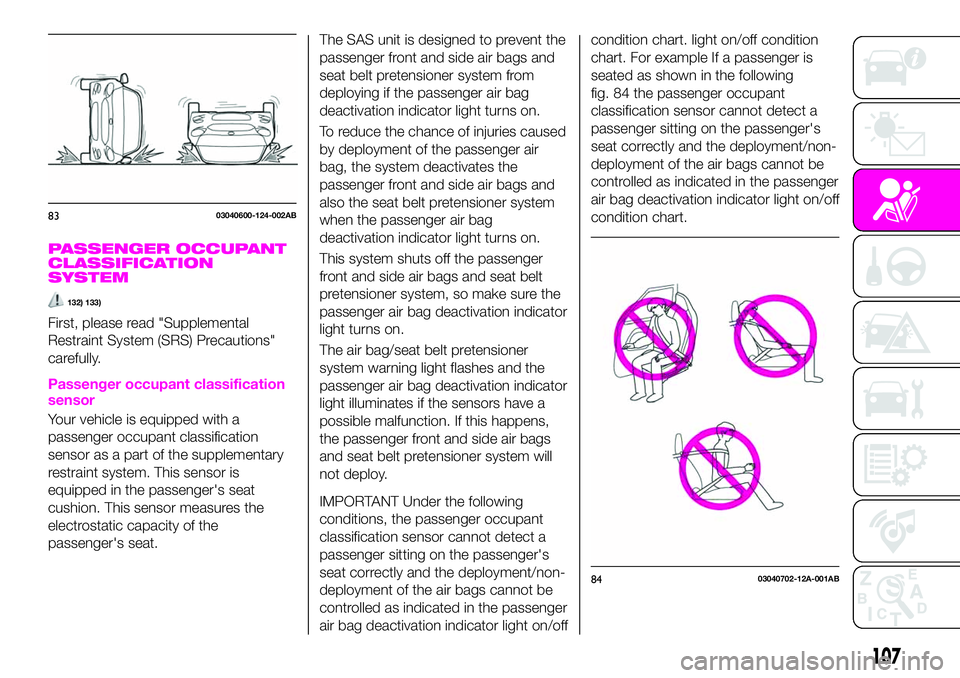
PASSENGER OCCUPANT
CLASSIFICATION
SYSTEM
132) 133)
First, please read "Supplemental
Restraint System (SRS) Precautions"
carefully.
Passenger occupant classification
sensor
Your vehicle is equipped with a
passenger occupant classification
sensor as a part of the supplementary
restraint system. This sensor is
equipped in the passenger's seat
cushion. This sensor measures the
electrostatic capacity of the
passenger's seat.The SAS unit is designed to prevent the
passenger front and side air bags and
seat belt pretensioner system from
deploying if the passenger air bag
deactivation indicator light turns on.
To reduce the chance of injuries caused
by deployment of the passenger air
bag, the system deactivates the
passenger front and side air bags and
also the seat belt pretensioner system
when the passenger air bag
deactivation indicator light turns on.
This system shuts off the passenger
front and side air bags and seat belt
pretensioner system, so make sure the
passenger air bag deactivation indicator
light turns on.
The air bag/seat belt pretensioner
system warning light flashes and the
passenger air bag deactivation indicator
light illuminates if the sensors have a
possible malfunction. If this happens,
the passenger front and side air bags
and seat belt pretensioner system will
not deploy.
IMPORTANT Under the following
conditions, the passenger occupant
classification sensor cannot detect a
passenger sitting on the passenger's
seat correctly and the deployment/non-
deployment of the air bags cannot be
controlled as indicated in the passenger
air bag deactivation indicator light on/offcondition chart. light on/off condition
chart. For example If a passenger is
seated as shown in the following
fig. 84 the passenger occupant
classification sensor cannot detect a
passenger sitting on the passenger's
seat correctly and the deployment/non-
deployment of the air bags cannot be
controlled as indicated in the passenger
air bag deactivation indicator light on/off
condition chart.
8303040600-124-002AB
8403040702-12A-001AB
107